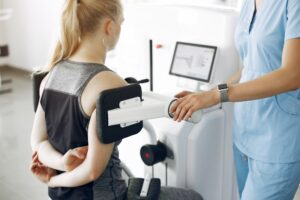Sports injuries are injuries that typically occur while participating in organized sports, competitions, training sessions, or organized fitness activities. These injuries may occur for a variety of reasons, including improper training, lack of appropriate footwear or safety equipment, and muscle imbalance.
There are two general types. The first type is called an acute traumatic injury. Acute traumatic injuries usually involve a single blow from a single application of force – like getting a cross-body block in football. Acute traumatic injuries include the following:
- Fracture: a crack, break or shattering of a bone
- Bruise (contusion): caused by a direct blow, which may cause swelling and bleeding in muscles and other body tissues
- Strain: a stretch or tear of a muscle or tendon, the tough and narrow end of a muscle that connects it to a bone
- Sprain: a stretch or tear of a ligament, the tissue that supports and strengthens joints by connecting bones and cartilage
- Abrasion: a scrape
- Laceration: a cut in the skin that is usually deep enough to require stitches.
The second type of sports injury is called an overuse or chronic injury. Chronic injuries are those that happen over a period of time. Chronic injuries are usually the result of repetitive training, such as running, overhand throwing, or serving a ball in tennis. These include:
- Stress fractures: tiny cracks in the bone’s surface often caused by repetitive overloading (such as in the feet of a basketball player who is continuously jumping on the court)
- Tendonitis: inflammation of the tendon caused by repetitive stretching
- Epiphysitis or apophysitis: growth plate overload injuries
Often overuse injuries seem less important that acute injuries. You may be tempted to ignore that aching in your wrist or that soreness in your knees, but always remember that just because an injury isn’t severe doesn’t mean it will go away on its own. If left untreated, a chronic injury will probably get worse over time.
Neck injuries are among the most dangerous sports related injuries. You can hurt your neck through a sudden traumatic injury in sports like mountain climbing, skydiving, horseback riding, gymnastics, diving, rugby, judo, or boxing.
Neck injuries include strains, fractures, contusions, sprains, and a stinger or burner from stretched nerves in the neck. Most neck injuries are caused by impact to the head or neck sustained during a fall or a blow. Your neck can also be injured a little at a time. Too much strain on your neck can cause increasing pain, sometimes only on one side of your neck. Sometimes you may feel only a slight pain when you move a certain way.
Serious head and neck injuries occur most often in athletes who participate in contact sports (like football or rugby) or sports with the potential for falling accidents, such as horseback riding.
Back Injuries
Back injuries include sprains, fractures, contusions, stress fractures, and strains and are caused by twists or overexertion of back muscles during bending or lifting movements. These injuries can occur in contact sports like football and ice hockey or in weight lifting, figure skating, gymnastics, dancing, baseball, and basketball.
Hand and Wrist Injuries
Hand, finger, and wrist injuries include fractures, dislocations, and sprains and often occur in contact sports such as football, lacrosse, and hockey. Hand injuries can result from a fall that forces the hand or fingers backward, a forceful impact to the hands, or a direct blow.
Foot Injuries
Foot injuries can include ligament strains, stress fractures, heel bruises, and a swollen growth plates. Because your feel support all of your weight and must absorb a lot of force over and over again, they can be particularly susceptible to injury. Some people have flat feet or high arches which may require foot orthotics or shoe inserts.
Taking Care of Sports Injuries
Any injury that results in swelling, numbness, intense pain or tenderness, stiffness, or loss of flexibility should be taken seriously.
You should also know the difference between soreness and chronic pain. Soreness is temporary, but chronic pain continues over a greater length of time.
The most important thing to do when you suspect that you are injured is to stop doing whatever sport has caused the injury right away and go see a doctor.
Once the doctor knows the full extent of your injury, he or she usually will recommend physical therapy along with rest and ice to help decrease swelling. Pain relief and anti-inflammatory medicines such as Ibuprofen (like Advil or Motrin) may be prescribed. Splints, casts, and surgery also may be needed, depending on the injury.
Your rehabilitation program will help you stay fit as you recover. Rehabilitation, or rehab, is the process that gets you back in shape and ready for action again. Rehab includes exercise, manual therapy from a physical therapist, and ultrasound. Ultrasound equipment is used to heat the injured area. This heat relieves pain, promotes healing, and increases your range of motion.
Our physical therapists are specially trained at treating sports injuries and have treated athletes from the Atlanta Hawks, WWF wrestlers, and Emory University soccer team.




